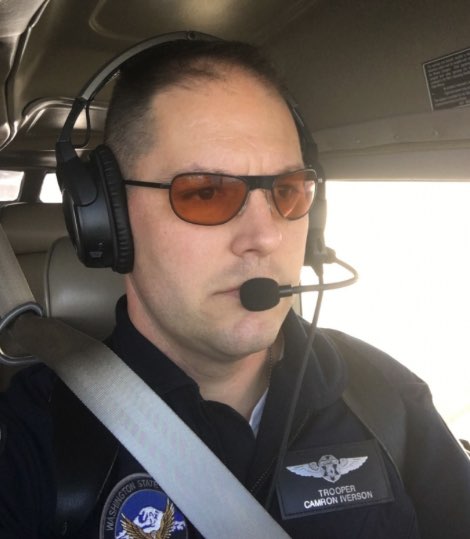Home
A comprehensive resource for safe and responsible laser use
US: Air Force develops laser glare protection glasses for pilots
05 May 2021 -- Categories: Anti-laser protection | Military and state use | Ways to reduce incidents
From a May 4 2021 news release in the Defense Visual Information Distribution Service, part of the U.S. Department of Defense:
Story by Mary Pacinda, Air Force Research Laboratory
Aiming a laser at an aircraft is a federal crime that can net offenders up to five years in jail or cost them a $250,000 fine. Even with this heavy potential penalty, laser strikes have become increasingly more common. According to the FAA, 6,852 such incidents were reported in 2020, compared with 385 in 2006, and so far this year, incidents of “joy lasing” are up 20 percent over last year. Cheap and easily obtained, hand-held lasers used as pointers and cat toys are certainly harmless when used as intended. But when they are aimed at the cockpit of an aircraft, they can temporarily blind the pilot — with possibly deadly consequences.
Laser strikes are almost always made at low altitudes when an aircraft is taking off or preparing to land — the two parts of flying that require the most attention from a pilot. Even if the beam of light does not hit the pilot’s eyes directly, it can cause a distraction or even raise an alarm that the plane may have become a target. In addition to the possible adverse effects of these human reactions, slight imperfections in the plane’s windscreen can cause the laser light to spread out, creating a glare that can temporarily obscure all vision inside the cockpit.
Of course, passing a law against any behavior — including pointing a laser at an airplane — seldom puts an end to the behavior. Thus, the best way to avoid disaster from laser strikes is to provide some sort of protection for the pilot. As a result, in recent years several manufacturers have developed laser eye protection (LEP) to meet a growing demand for help from military and law enforcement pilots. But this solution is not without problems of its own.
Most laser eye protection works by filtering out green or red light, the colors most commonly used in handheld lasers. Unfortunately, according to FAA studies and years of pilot experience, this can change the pilot’s ability to accurately read the instrument control panel. A 2019 FAA report suggested that this problem might be fixed by changing the type of lighting in the control panel.
Researchers at the Air Force Research Laboratory recently came up with a better solution, one that was successfully tested on the job by Washington State Patrol pilots.
Washington State Patrol pilots successfully test special laser eye protection developed at Wright-Patterson Lab
Story by Mary Pacinda, Air Force Research Laboratory
Aiming a laser at an aircraft is a federal crime that can net offenders up to five years in jail or cost them a $250,000 fine. Even with this heavy potential penalty, laser strikes have become increasingly more common. According to the FAA, 6,852 such incidents were reported in 2020, compared with 385 in 2006, and so far this year, incidents of “joy lasing” are up 20 percent over last year. Cheap and easily obtained, hand-held lasers used as pointers and cat toys are certainly harmless when used as intended. But when they are aimed at the cockpit of an aircraft, they can temporarily blind the pilot — with possibly deadly consequences.
Laser strikes are almost always made at low altitudes when an aircraft is taking off or preparing to land — the two parts of flying that require the most attention from a pilot. Even if the beam of light does not hit the pilot’s eyes directly, it can cause a distraction or even raise an alarm that the plane may have become a target. In addition to the possible adverse effects of these human reactions, slight imperfections in the plane’s windscreen can cause the laser light to spread out, creating a glare that can temporarily obscure all vision inside the cockpit.
Of course, passing a law against any behavior — including pointing a laser at an airplane — seldom puts an end to the behavior. Thus, the best way to avoid disaster from laser strikes is to provide some sort of protection for the pilot. As a result, in recent years several manufacturers have developed laser eye protection (LEP) to meet a growing demand for help from military and law enforcement pilots. But this solution is not without problems of its own.
Most laser eye protection works by filtering out green or red light, the colors most commonly used in handheld lasers. Unfortunately, according to FAA studies and years of pilot experience, this can change the pilot’s ability to accurately read the instrument control panel. A 2019 FAA report suggested that this problem might be fixed by changing the type of lighting in the control panel.
Researchers at the Air Force Research Laboratory recently came up with a better solution, one that was successfully tested on the job by Washington State Patrol pilots.

Flight Officer Camron Iverson of the Washington State Patrol tested laser protection lenses formulated at AFRL’s Materials and Manufacturing Directorate. (Photo by Mary Pacinda)
The Personnel Protection Team in AFRL’s Materials and Manufacturing Directorate, headed by Dr. Matthew Lange, used the cockpit compatibility design software developed for Department of Defense LEP and modified it for commercial use. The commercial version, called CALI (Commercial Aviation Low Intensity) filters out the laser light, but not the light coming from the pilot’s instrument panel. “Simply put,” said Lange, “the lenses maximize protection while minimizing the impact to the cockpit.”